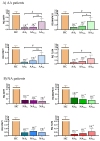Molecular Study from the Signaling Pathways of Four Potential asthma triggers: AKT1, MAPK13, STAT1, and TLR4
- PMID: 40650018
- PMCID: PMC12249927
- DOI: 10.3390/ijms26136240
Molecular Study from the Signaling Pathways of Four Potential asthma triggers: AKT1, MAPK13, STAT1, and TLR4
Abstract
Asthma is a chronic and heterogeneous inflammatory airway disease with diverse clinical endotypes and limited curative treatment options. Recent systems biology analyses identified four potential molecular triggers-AKT1, MAPK13, STAT1, and TLR4-as candidate regulators of asthma-associated signaling pathways. This study aimed to validate the expression of these four proteins and their downstream signaling elements in peripheral blood mononuclear cells (PBMCs) from patients with allergic asthma (AA), nonallergic asthma (NA), and healthy controls (HC), to explore their potential as biomarkers or therapeutic targets. For that, PBMC samples were collected from 45 AA patients, 17 NA patients, and 15 HC subjects. Gene and protein expression of AKT1, MAPK13, STAT1, and TLR4 were quantified using RT-qPCR and Western blotting. Expression patterns were compared across groups and stratified by asthma severity. Correlations with clinical parameters (FEV1, FVC, FeNO, IgE, eosinophil counts) and treatment regimens were also assessed. All four target genes showed significantly reduced expression in asthma patients compared to controls (p < 0.001), with the most marked downregulation in NA patients. At the protein level, MAPK13 and TLR4 showed significant differential expression. Stratification by severity revealed a stepwise reduction in gene expression in AA patients, correlating with disease severity, whereas NA patients showed uniformly low expression regardless of severity. Multiple pathway-related genes, including RELA, SMAD3, NFATC1, and ALOX5, were also downregulated, particularly in NA patients. Notably, differential correlations were observed between gene expression and lung function parameters in AA vs. NA groups. In conclusion, this study supports the potential involvement of AKT1, MAPK13, STAT1, and TLR4 in asthma pathogenesis and highlights differences between allergic and nonallergic asthma at the molecular level. These proteins and their associated pathways may serve as future targets for biomarker development or endotype-specific therapies. Further studies in larger and more diverse cohorts, including functional validation, are warranted.
Keywords: AKT1; MAPK13; STAT1; TLR4; allergic asthma (AA); asthma; biomarkers; gene expression; nonallergic asthma (NA); peripheral blood mononuclear cells (PBMCs); signaling pathways.
Conflict of interest statement
The authors declare no conflicts of interest.
Figures


Similar articles
-
CD177, MYBL2, and RRM2 Are Potential Biomarkers for Musculoskeletal Infections.Clin Orthop Relat Res. 2025 Jun 1;483(6):1062-1071. doi: 10.1097/CORR.0000000000003402. Epub 2025 Feb 6. Clin Orthop Relat Res. 2025. PMID: 39915095
-
Systemic pharmacological treatments for chronic plaque psoriasis: a network meta-analysis.Cochrane Database Syst Rev. 2021 Apr 19;4(4):CD011535. doi: 10.1002/14651858.CD011535.pub4. Cochrane Database Syst Rev. 2021. Update in: Cochrane Database Syst Rev. 2022 May 23;5:CD011535. doi: 10.1002/14651858.CD011535.pub5. PMID: 33871055 Free PMC article. Updated.
-
Inflammatory and clinical risk factors for asthma attacks (ORACLE2): a patient-level meta-analysis of control groups of 22 randomised trials.Lancet Respir Med. 2025 Jun;13(6):505-516. doi: 10.1016/S2213-2600(25)00037-2. Epub 2025 Apr 8. Lancet Respir Med. 2025. PMID: 40215991 Free PMC article.
-
[Electroacupuncture of "Jiaji"(EX-B2) improves asthma by reducing airway inflammation and regulating PI3K/AKT/mTOR signaling pathway in rats with allergic asthma].Zhen Ci Yan Jiu. 2025 Jun 25;50(6):666-674. doi: 10.13702/j.1000-0607.20241336. Zhen Ci Yan Jiu. 2025. PMID: 40551649 Chinese.
-
Comprehensive single-cell chromatin and transcriptomic profiling of peripheral immune cells in nonsegmental vitiligo.Br J Dermatol. 2025 Jun 20;193(1):115-124. doi: 10.1093/bjd/ljaf041. Br J Dermatol. 2025. PMID: 39888372
References
-
- GINA. Global Initiative for Asthma Global Strategy for Asthma Management and Prevention. 2021. [(accessed on 28 May 2024)]. Available online: http://www.ginasthma.org/
MeSH terms
Substances
LinkOut - more resources
Full Text Sources
Medical
Research Materials
Miscellaneous

